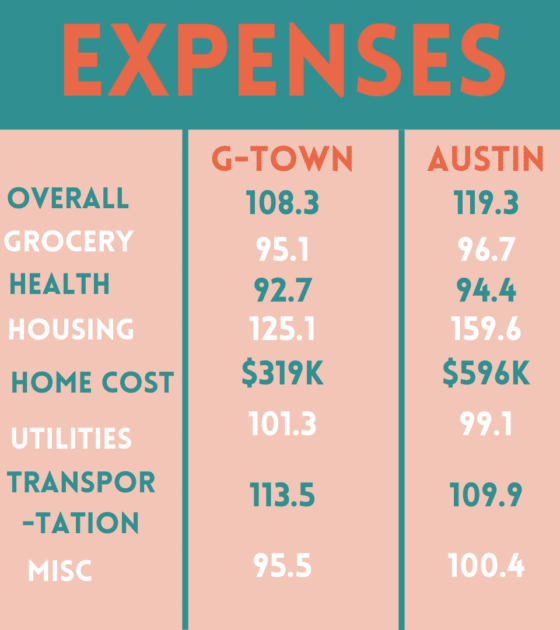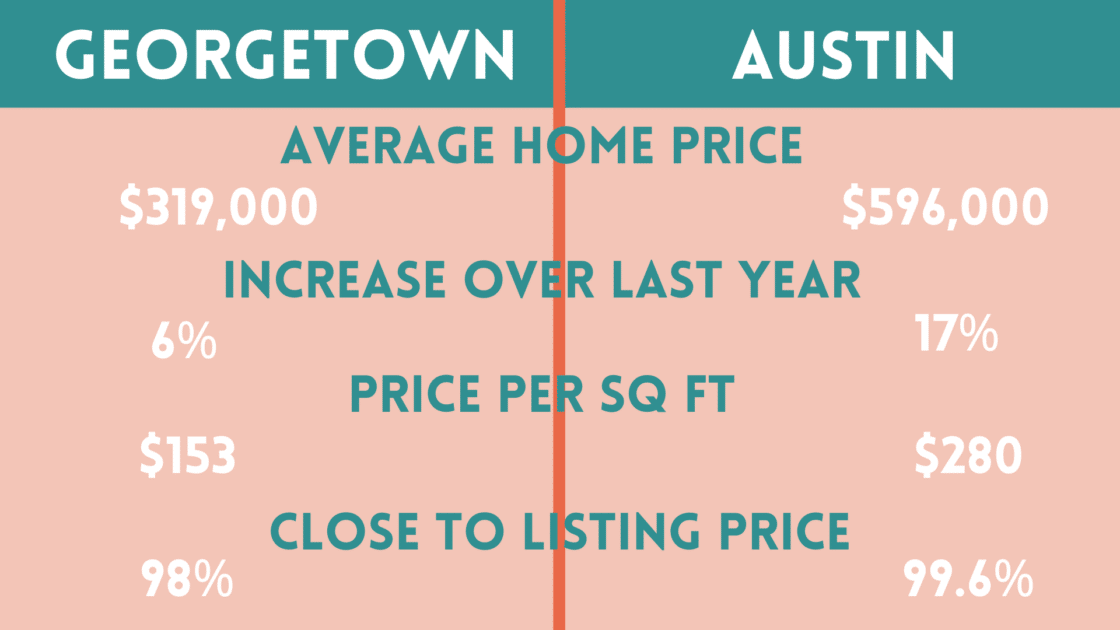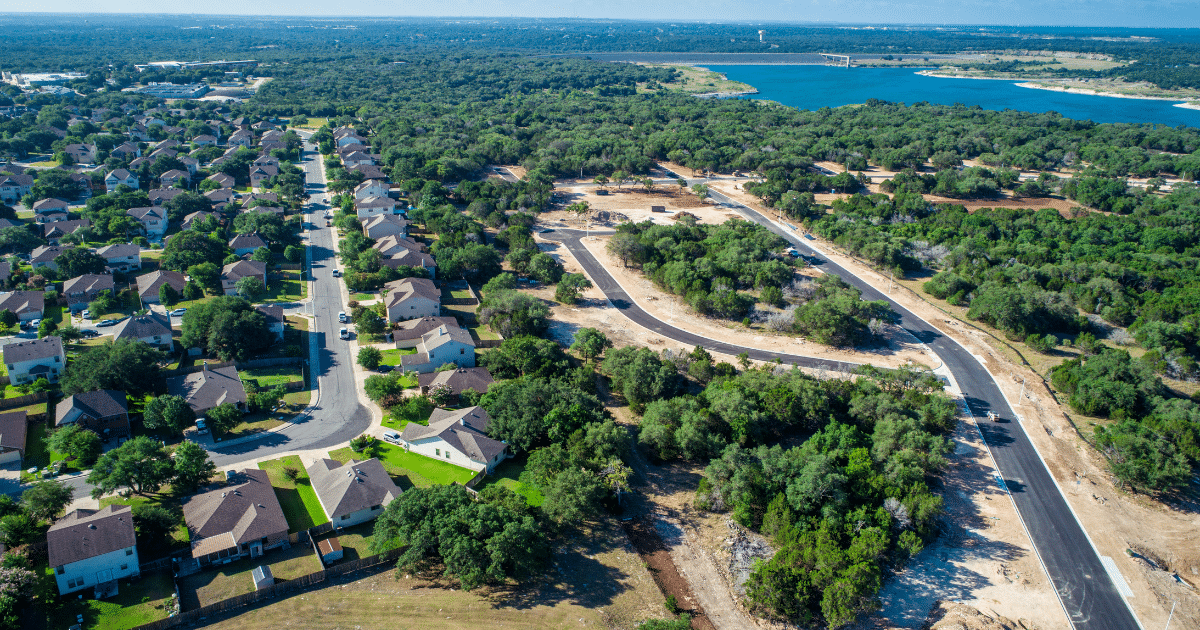We’re talking about the difference in cost of living between Georgetown, Texas and Austin, Texas. People are moving out here from California, New York, Minnesota and even Vietnam. And you have no idea what’s what, so we’re gonna talk about all of that here.
Austin vs Georgetown
Let’s get started!
Overall, the cost of living in Texas is lower than the national average. The national average is 100%, Texas is 94%, whereas Austin and Georgetown are going to come in a little bit higher than the average. The average cost of living in Georgetown, it’s on an index of 108% and in Austin, it’s 119%. The reason the cost of living in Austin and Georgetown is higher than that in the rest of the country is because of housing and transportation costs, but everything else is either at or below the national average, like healthcare, groceries, utilities.
Let’s look at those expenses comparing Austin and Georgetown.

#image_title
Groceries are lower than the average for both Austin and Georgetown. Georgetown’s at 95% and Austin’s at 96%, which is pretty similar healthcare. This is everything from your health insurance, your doctor’s visits, your bandaids, your toothpaste, stuff like that. The health costs are going to be lower in Georgetown than in Austin, about 92% on the index versus 94%. Again, pretty comparable, not too much of a drastic difference.
The housing costs in Georgetown are 25% higher on the index than the national average and in Austin, it’s 60% higher. These are the main forces that are driving the cost of living to be higher than the national average in Georgetown and in Austin. The average home costs in Georgetown in the summer of 2020 was $319,000 and in Austin, it was $596,000. That is a huge difference between the average home sales from Georgetown to Austin.
Utilities are a little bit higher in Georgetown, they’re at 101% versus Austin at 99%.
Transportation again, is the other factor that’s higher than the national average. It’s driving the cost of living up, not nearly as much as housing, but it is something that’s above the national average. Georgetown transportation cost is about 113% and Austin it’s 109%. That’s one factor that’s a little bit lower in Austin than in Georgetown but still higher than what you’re going to find with the national average.
There are some miscellaneous costs like restaurants, shopping, entertainment, basically whatever else you spend your money on. In Georgetown, it’s 95.5% and in Austin it’s 100%, so just about the national average.
The cost of living in Texas on that index scale is 94% and that’s Texas as a whole. Then we talked about cost of living for Georgetown it’s 108% and for Austin it’s 119%. The major reasons for those costs being so high is because of housing. Let’s dig into the housing numbers, comparing Austin to Georgetown.

#image_title
The average home price in Georgetown in summer of 2020 was $319,000 and in Austin was $596,000. That’s pretty close to double the home price from Georgetown to Austin and this is a huge deal. It’s why the cost of living in Austin is so much higher than that in Georgetown.
The average home price in Georgetown has increased by 6% and in Austin it has increased by 17%. The home prices in Austin are higher and they’re growing at a faster rate. If you’re thinking about where to buy an investment property, Austin is going to appreciate faster, but Georgetown is going to be a little bit easier to get into on the ground level especially if you don’t have $600,000 to spend for your first investment home in Austin.
How much are we paying per square foot in Georgetown versus in Austin? In Georgetown we’re paying $153 per square foot and in Austin, we’re paying $280. Sometimes houses in Austin can be much bigger or much smaller than homes in Georgetown and vice versa. There’s just different styles and different neighborhoods. We wanna make sure that we’re comparing apples to apples.
15 years ago, when a home went on the market, you would list it and the buyer would come in, you’d have some kind of negotiation going back and forth. Maybe you sell that home for $10,000 less than what you listed it at, cuz you’re expecting to do some negotiations. The way that the market is today in Austin and in Georgetown, basically everywhere in the Austin area that it’s just not happening. There’s so much competition and there’s so few houses that are for sale that they’re getting snatched up, a lot of times above asking price and sometimes right at or just barely below asking price.

#image_title
Georgetown homes are selling for 98% of the original asking price. If you put your home up for $300,000, it’s gonna sell for about $294,000. There basically are no deals, there’s no haggling, you’re not going to save a ton of money. It’s just not the way that the economy is working right now in the Austin area. We’re talking about supply and demand. There’s very little supply and there’s a lot of demand. You really don’t have a lot of negotiating power when you’re going to buy a home in Georgetown or in Austin.
In Austin, houses are sold for 99.6% of the original listing price. Pretty much a hundred percent of the listing price. You’ve got to go in there and offer either the asking price or higher if you want to buy a house in Austin.
Another factor to consider when you’re looking at buying a home of real estate in Austin are taxes and the tax rates. Texas has no income tax, but instead we have significant property taxes.
How does the property taxes compare in Austin versus Georgetown?
The property tax rate is pretty comparable in Georgetown. You could be paying anywhere from 1.85% to 3%. And in Austin, anywhere from 1.65% to 3%, that’s for homes that are on the market today right now and it all depends on what neighborhood you’re in. Some neighborhoods are lower, some are higher, but definitely they’re gonna be pretty uniform within a certain area that you’re looking in.
Gas in Texas is pretty reasonable. It’s not nearly as bad as California where you’re paying like $2.75-$3 a gallon. In Austin right now, right around the corner from my house, gas is $1.69 a gallon. The average right now, if you’re going in downtown Austin, it’s gonna be about $1.89 a gallon. And in Georgetown gas is about $1.79 a gallon. Pretty comparable, only like a 10 cent difference in price per gallon. Over time that’s gonna add up, but for every fill, it’s not really going to be too big of a deal.
Overall it is much cheaper to live in Georgetown than it is in Austin for the major factors of housing and transportation. Everything else is pretty much the same price. The housing in Austin is just insane, but if you’re able to buy, then your appreciation is gonna explode along with the market.
Something to keep in mind, the cool thing about Georgetown is it’s kind of like two different cities in one. Around the university and around downtown Georgetown, you have a lot of really old historic cool homes. And 15-20 minutes outside, you have this explosion of new construction. We talked about the supply and demand factor. There’s more supply coming. Unfortunately it’s not coming fast enough. The builders still aren’t able to keep up with the demand from buyers, but there is more on the way. A factor to keep in mind is even though there is more construction, there’s still more buyers than there are houses.
When you’re talking about moving to Georgetown versus Austin, it’s gonna be a little bit less of a hassle to go to Georgetown and you’re going to stretch your dollar farther but it is a different city. So if you’ve got to commute down to downtown Austin or even into places like Allendale or Crestview, that commute is definitely going to be something that you want to factor in. Overall the total cost of living Georgetown is gonna be cheaper than Austin.
Hands down.



